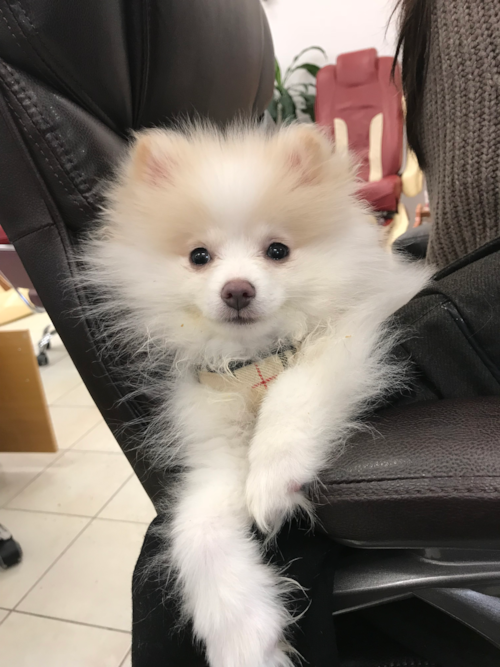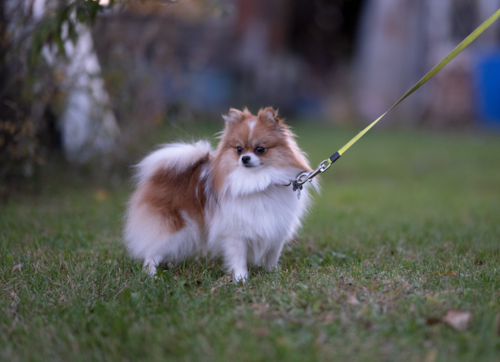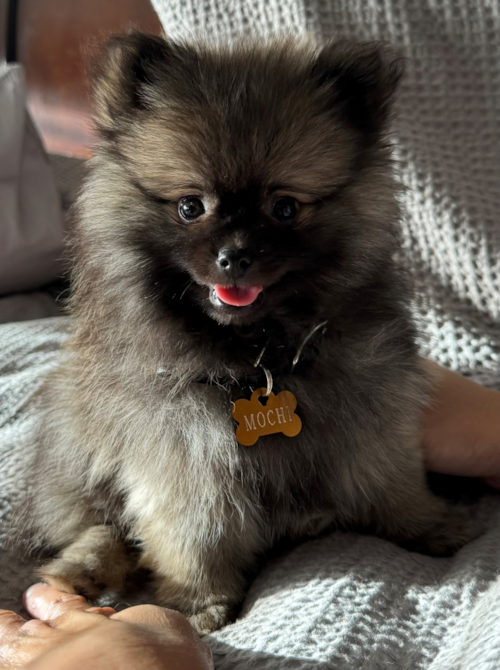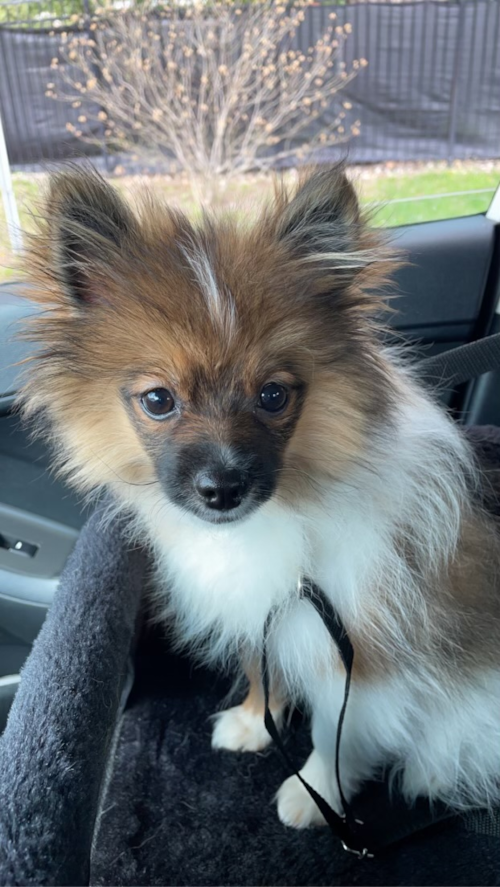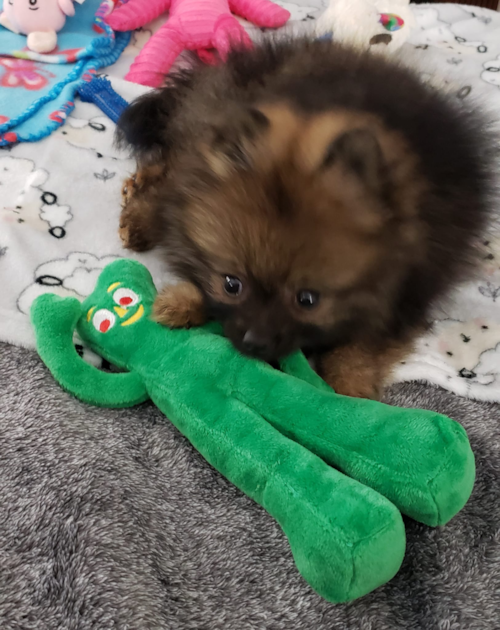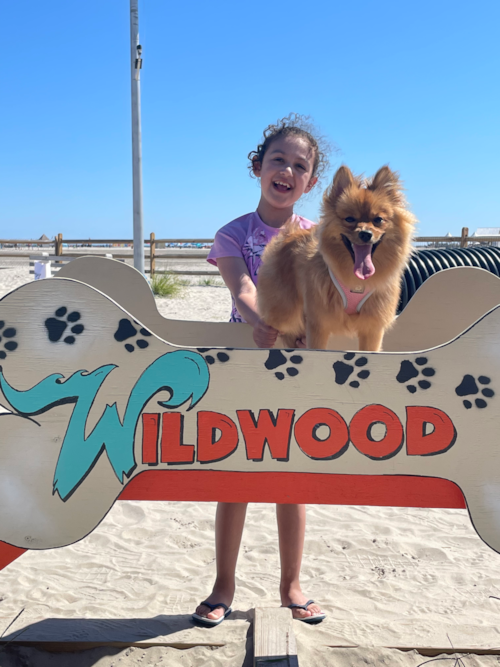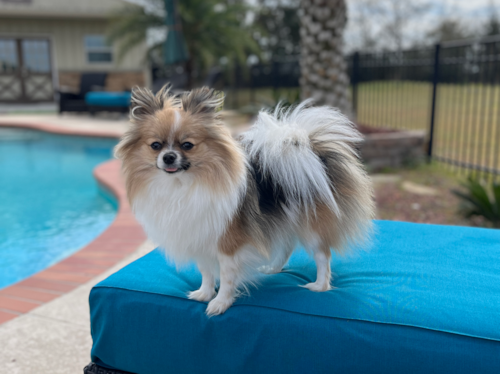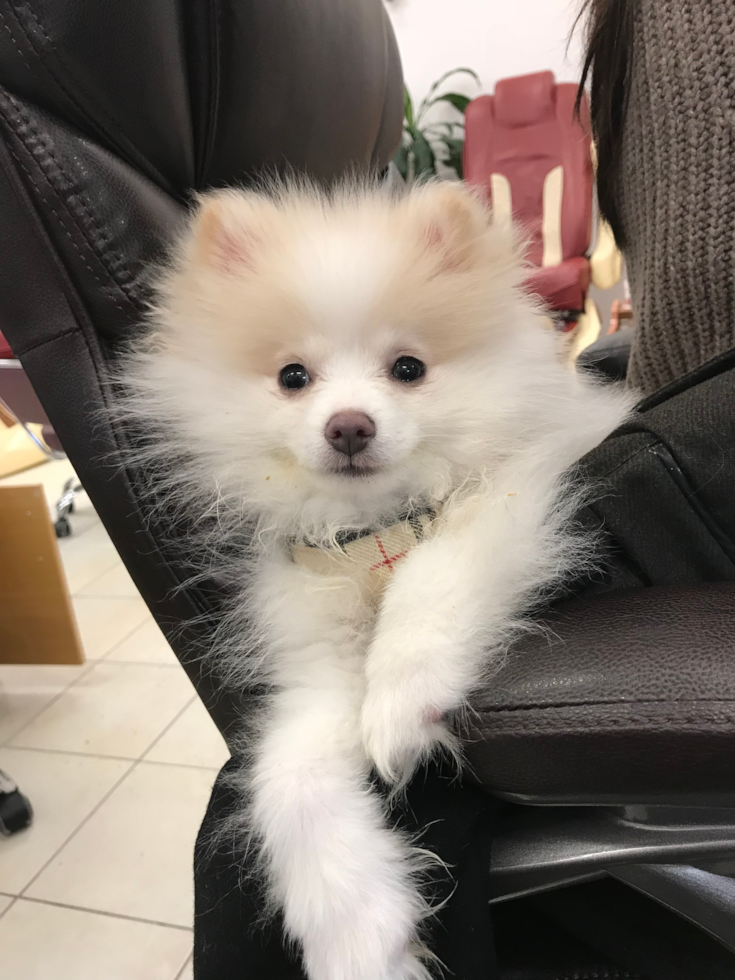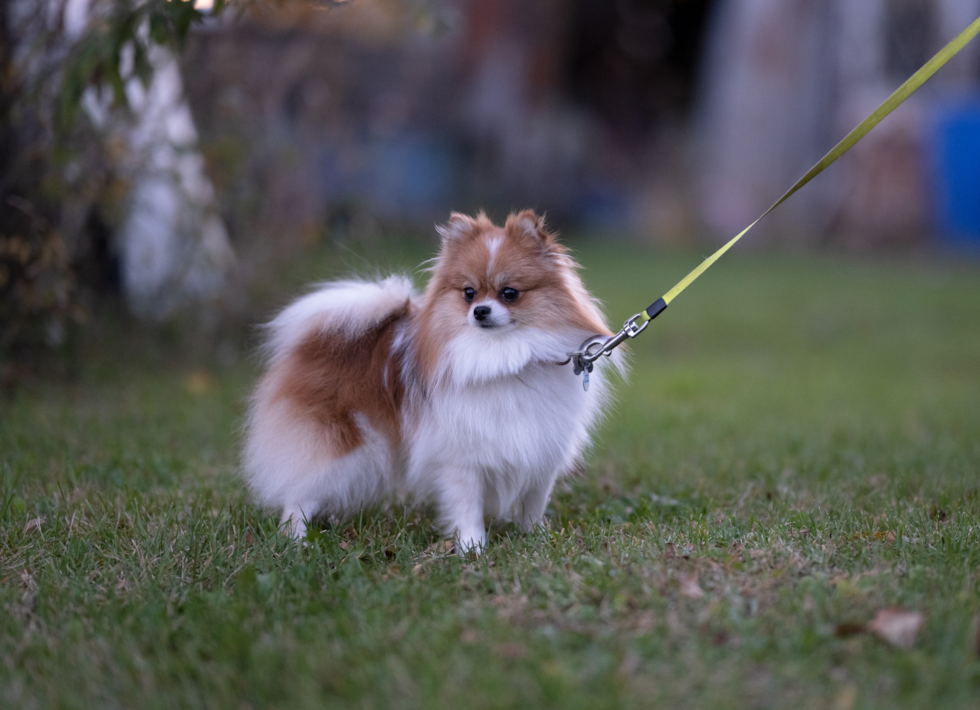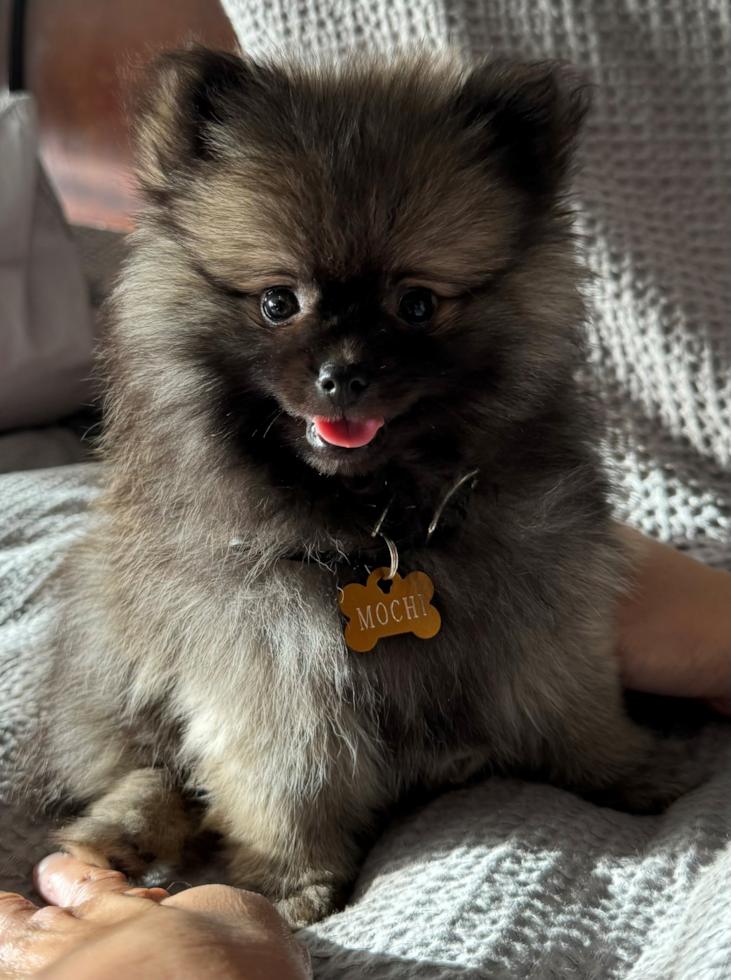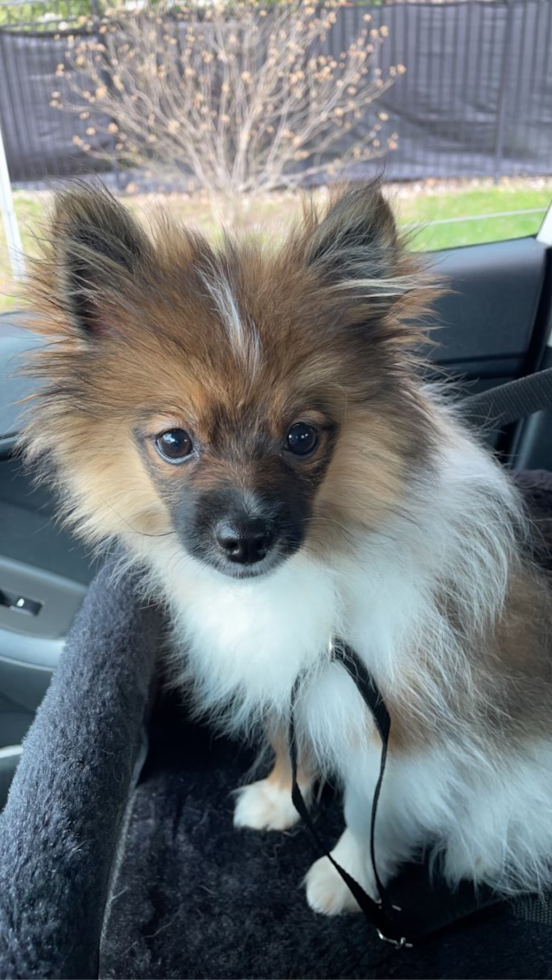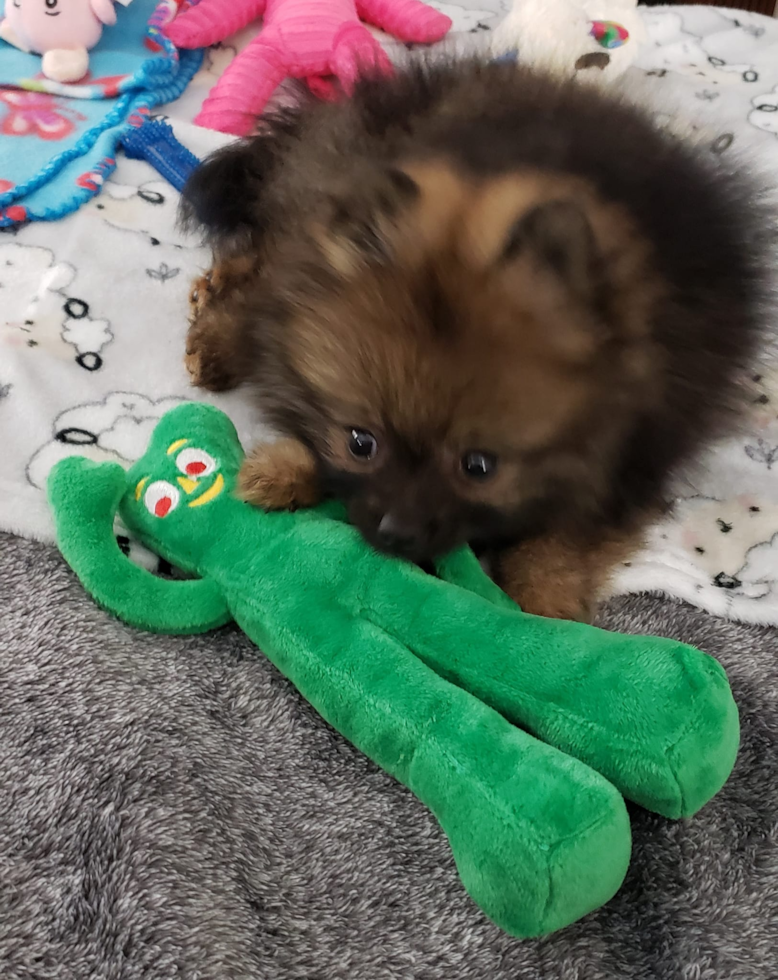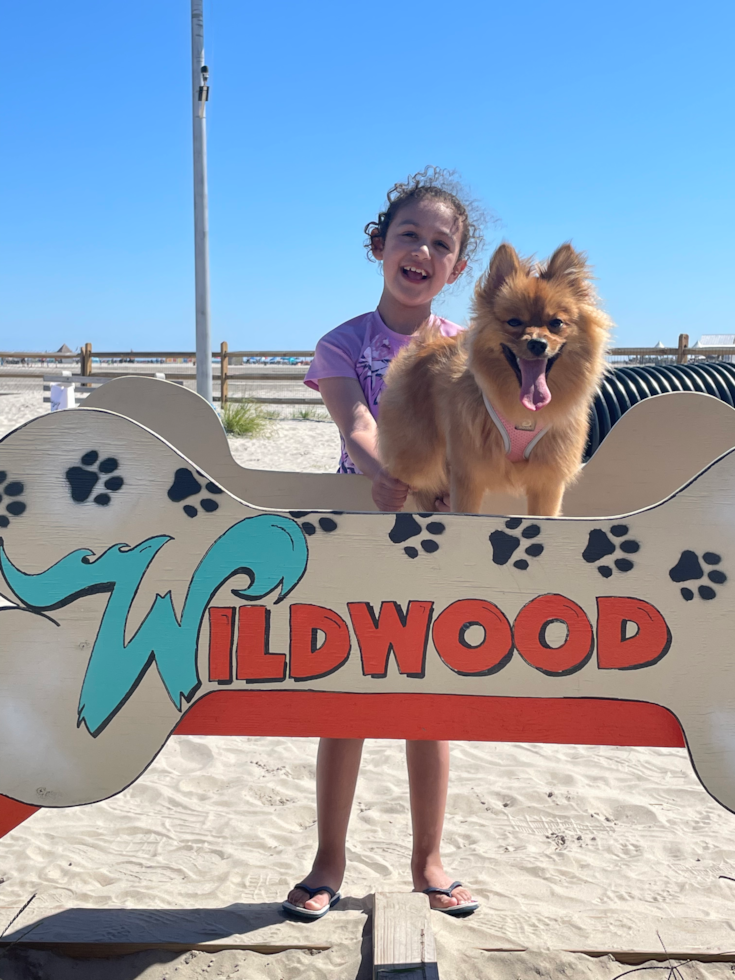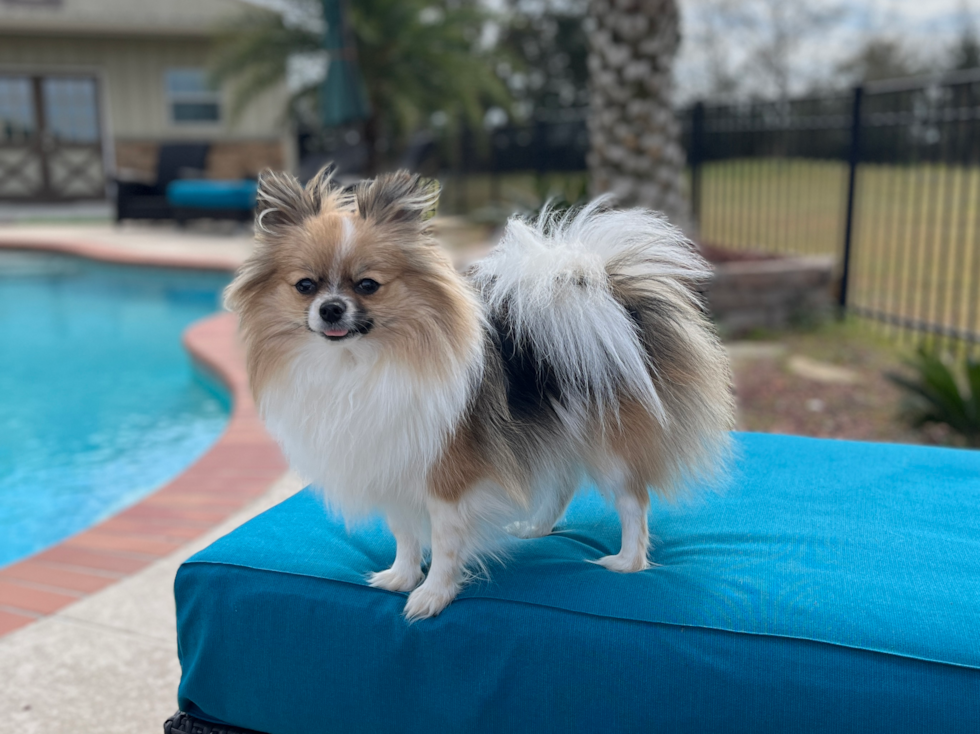Pomeranian Breed Information

Are you looking for a little dog with a big personality? Well, meet the Pomeranian, affectionately known as the Pom. These fluffy, pocket-sized powerhouses are not just adorable, they're also incredibly intelligent. Bursting with charm and energy, Poms captivate hearts with just one look. Their fluffy coats and sparkling eyes make them look like tiny teddy bears - you won't be able to resist their cuteness!
Now, you might hear the Pomeranian being referred to as the Dwarf Spitz, Loulou, or Zwergspitz in different parts of the world. Regardless of the name, one thing remains the same - this breed's remarkable intelligence. Quick to learn and always eager to please, Pomeranians love to show off their smarts. They're curious and alert, making them great little watchdogs. But don't worry, they're just as friendly as they are protective.
So, if you're looking for a furry family companion that's as smart as they are sweet, the Pomeranian dog breed might just be your perfect match. These little dogs are so much more than their tiny size - they're full of love, loyalty, and a zest for life that's truly inspiring. Get ready for endless fun and love when you welcome a Pom into your life!
Scroll down to see important characteristics and facts about Pomeranians.
Characteristics
- Breed Names: The Pomeranian is known by many names, making this breed as versatile as it is adorable. Other names the Pomeranian goes by include Pom, Dwarf Spitz, Loulou, and Zwergspitz.
- Smallest Spitz: Pomeranians are the smallest members of the Spitz family. Their lineage traces back to large sled dogs, and they've retained much of their ancestral hardiness despite their petite size.
- Friendly: Pomeranians are known for their friendly nature, but they do require proper socialization. This helps ensure that they're comfortable and confident in various situations, from meeting new people to encountering other animals.
- Distinctive Appearance: This breed's foxy face, bright eyes, and plumed tail are distinctive features that set Pomeranians apart. Their fluffy double coat and compact size also make them instantly recognizable and endearingly cute.
- Variety of Colors: One of the great things about Pomeranians is their variety of colors. From solid hues to multi-colored patterns, Poms can be found in almost every color under the sun, including white, black, brown, orange, grey, and more.
- Excellent Watchdogs: Despite their small size, Pomeranians make great watchdogs. They are naturally alert and protective, and they won't hesitate to bark when they notice something amiss.
- Intelligence: Pomeranians are highly intelligent, which makes them both entertaining companions and quick learners. Their keen intelligence shines through in their curious nature and their ability to pick up commands and tricks quickly.
- High Energy Levels: These little dogs are packed with energy. They love to play, explore, and stay active, making them perfect companions for those who enjoy an energetic lifestyle.
- Grooming Needs: Their beautiful double coat requires regular grooming to stay healthy and beautiful. Brushing, bathing, and occasional trims are necessary to keep your Poms looking their best.
- Therapy Dogs: The friendly, empathetic nature of Pomeranians makes them fantastic therapy dogs. Their small size allows them to be comfortable in various settings, from hospitals to nursing homes, spreading joy wherever they go. Their intelligence and ability to learn commands quickly also contribute to their success in this role.

Appearance
One of the great things about Pomeranians is that they manage to pack a whole lot of personality into a compact package. Pomeranians often are among the smallest of the purebred dogs, typically standing between 6 to 7 inches tall at the shoulder and weighing anywhere from 3 to 7 pounds. Despite their petite size, they are robust and resilient, with a sturdy build that belies their small stature.
The Pomeranian breed standard specifies a fox-like countenance, and when you look at a Pom, it's easy to see why. Their eyes are dark, almond-shaped, and sparkle with a lively, intelligent expression. Their ears, too, contribute to their fox-like appearance. They are small, set high on the head, and always stand erect, giving the Pomeranian a look of alertness and curiosity.
The tail is one of the Pomeranian's most distinctive features. A Pom's tail is plume-like, arching gracefully over the back and lying flat, with the fur spreading out like a fan. From the moment Poms are born, their tails start to curl upwards, and by the time they are a few months old, their tails should be forming the characteristic plume.
Their bodies are compact but muscular, with a level back and a moderate tuck-up. Despite their small size, Pomeranians are agile and energetic, capable of more physical activity than you might expect from such a petite dog.
Part of the appeal of Pomeranians lies in their magnificent fur. Each Pom boasts a double coat, a distinctive feature that contributes to its fluffy and endearing appearance. The inner layer is short and dense, providing insulation and warmth, while the outer layer is long, straight, and stands off the body, giving the Pomeranian its glory and fluffiness.
One of the practical aspects to consider with this double coat is shedding. Pomeranians, like all double-coated breeds, shed throughout the year, and heavily during the changing of seasons. Regular grooming can help manage the shedding, ensuring your Pom always looks its best and your home stays relatively fur-free.
In terms of colors, Pomeranians offer a rainbow of choices, boasting one of the widest varieties of coat colors among dog breeds. This includes white Poms, particularly popular for their striking, snowy appearance. But the spectrum doesn't stop there. You'll find Poms that are black, brown, orange, cream, blue, sable, and many shades in between. Some Pomeranians even have a mix of colors or patterns, making each Pom uniquely beautiful.
Photos
Temperament
The Pomeranian, with its vivacious and outgoing nature, is truly a breed that stands out in the dog world. When we speak of a dog's temperament, we're referring to its inherent traits, its attitude toward people and other animals, and its ability to socialize. These characteristics, shaped by a combination of genetic, environmental, and social factors, give each breed, and indeed each dog, its unique personality.
Pomeranians, as a breed, are known for their boldness and curiosity. Despite their small size, they carry themselves with an air of confidence and audacity. They are extroverted dogs, always ready to explore their surroundings and meet new friends. This combination of fearlessness and curiosity makes them lively and engaging companions.
These little dogs also possess a keen intellect, which shines through in their quick understanding of commands and their knack for problem-solving. However, their intelligence coupled with their bold nature can sometimes lead them to be a bit stubborn, but that's all part of the Pom charm.
However, it's important to note that not all Pomeranians will exhibit these traits to the same degree. Like people, dogs are individuals, and their personalities can vary. For instance, while Pomeranians are generally sociable, some might be a bit more reserved. Similarly, while they are not known to be aggressive, some Pomeranians might exhibit protective behaviors, especially if they are not socialized properly from a young age.
Pomeranians may be small, but they certainly don't see themselves that way. These diminutive Pomeranians, or "theory dogs" as some like to call them, believe they're big dogs trapped in small bodies. Their courage knows no bounds, often leading them to confront much larger dogs. This 'big dog attitude' is a testament to their fearless and spirited nature.
When it comes to families, Poms are intelligent and adaptable, making them excellent companions for people of all ages. They are generally good with children, especially young adult dogs who have been properly socialized. However, due to their small size, it's important to supervise interactions between Pomeranians and small children to ensure gentle play. Despite their bravery, the smaller Poms might be at risk of injury during boisterous play.
For the elderly, Pomeranians make ideal pets. Their spirited yet manageable energy levels, combined with their love for companionship, align well with a quieter, more relaxed lifestyle. Plus, they're good apartment pets, adapting well to indoor living spaces, although they do tend to bark a lot. It's not so much a sign of aggression, but rather their way of communicating or responding to unfamiliar sounds and sights.
As with any breed, proper socialization is key to a well-adjusted Pomeranian. Exposure to various people, sights, sounds, and experiences, when they're young, helps ensure that your Pomeranian grows up to be a well-rounded dog. This early socialization will help to nurture their intelligence, enhance their sociability, and channel their bravery in a positive direction.
Insights

Pomeranian vs Shih Pom Comparison
Tiny dogs with big personalities and a great deal of love to give is what defines Pomeranian dogs and Shih Poms. If you find yourself wanting to choose between the two, you are in for quite a challenge as these dogs are equally precious, cuddly, sweet, and clever. Read on to learn more about what makes them special, what qualities they share, what they love, and how they stand out from one another.
A puppy’s love is a pure thing and, here at Premier...

Choosing the best dog breed for apartment living can be a tricky task. Some dog lovers believe that being small is all it takes for a dog to be suited for apartment life but that is not always the case.
Coming home to a loving bundle of joy is a dream come true, but there are a few other things to keep in mind when choosing your new apartment-friendly puppy.
Your neighbors, kids, and pets in the building, new faces, distractions, and quiet hours, are all things you...
Care
Grooming
Keeping your Pomeranian looking their best requires a commitment to regular grooming, a process that is as essential to their well-being as it is to their appearance. This tiny, fluffy family companion, resplendent with a double coat and a plume-like tail, demands a grooming routine that includes brushing, bathing, and trimming.
To start, consider investing in a quality brush, designed for breeds with double coats. Your Pomeranian will benefit from a good brush at least once a week, though, during their biannual shedding periods, you may find a need to increase this frequency. Consider this grooming session not just a maintenance chore, but a bonding activity with your Pom, allowing them to feel comfortable while being handled and maintaining their coat in prime condition.
Next, bathing is a regular aspect of a Pom's grooming routine. Regardless of their activity levels, all Poms need a bath roughly every three to four weeks to maintain a healthy skin and a vibrant coat. Always use a gentle, dog-friendly shampoo that won't strip their coat of its natural oils or cause skin dryness.
As for trimming, it's not about giving your Pom a full haircut - the natural length of their fur is best preserved. Rather, it's about keeping certain areas neat and tidy. Regularly check and trim the fur around your Pom's eyes, ears, and paws to prevent discomfort or obstruction of their vision.
To continue with your Pom's grooming, there are three more crucial areas that deserve your attention: nail care, dental hygiene, and ear cleaning. These are not just about keeping your Pomeranian looking smart, but also about maintaining their overall health and comfort.
Nail trimming should be a regular part of your Pom's grooming routine. Long, untrimmed nails can cause discomfort, affect your Pom's natural gait and potentially cause skeletal issues. Generally, Pomeranians need their nails trimmed every two to three weeks, but the exact frequency can vary based on your dog's activity level and the surfaces they walk on.
Next in line is dental care. Pomeranians, like many small breeds, can be prone to dental issues. Regular teeth cleaning can help prevent plaque build-up and gum disease. Aim to brush your Pom's teeth several times a week - every day if possible - using dog-specific toothpaste. Routine vet check-ups can also help ensure your Pom's dental health is on track.
Finally, ear cleaning is a must for Pomeranians. Their upright ears can accumulate dirt and wax, potentially leading to infections if not cleaned regularly. Make ear cleaning a part of your grooming routine, checking for any signs of redness, irritation, or unusual odors that might indicate an issue. Use a dog-approved ear cleaner and gently clean the outer area of the ear - always avoid inserting anything into the ear canal itself.
Exercise Needs
Pomeranians are generally a sprightly bunch, brimming with energy and enthusiasm. They are not just fluffy companions but also highly active dogs that love to be in the thick of the action. They thrive on interactions, play, and even a bit of mischief, making them an absolute joy to be around.
Despite their small size, Pomeranians need regular exercise to keep them happy and healthy. A couple of short walks a day, combined with some playtime, usually suffice. Poms love to explore and are quite adventurous, so walks are a great opportunity for them to sniff out new scents and satisfy their curiosity.
Indoor games are also a favorite with this breed. A simple game of fetch or hide-and-seek can keep a Pom entertained and provide a good workout. And don't be surprised if your Pom takes a liking to agility training. These energetic dogs love the mental and physical challenges that agility courses offer.
However, it's important to remember that while Pomeranians can be quite energetic, they can also tire easily. Their little legs might not be able to handle long hikes or runs like larger breeds. Care should be taken not to over-exert your Pom, and always ensure they have a comfortable place to rest after their adventures.
Health
With their lively spirit and boundless energy, Pomeranians are generally a healthy breed, though, like all breeds, they can be susceptible to certain health conditions. It's important to note that not all Pomeranians will encounter these issues, but being aware of them helps ensure you're providing the best care for your furry family companion.
Allergies are a common issue in Pomeranians. They can be allergic to a variety of things, including certain foods, chemicals found in cleaning products, or even pollen. Symptoms can include itchy skin, excessive scratching, or digestive issues. If you notice any signs of allergies in your Pom, it's important to consult with your vet to determine the cause and develop a management plan.
Eye problems can occur in Poms, just like in many other purebred dogs. Conditions such as cataracts, which can cause cloudiness in the eye, and dry eye, a condition where the eyes don't produce enough tears, can affect Pomeranians. Regular vet checks can help identify these conditions early, ensuring your Pom's eyes remain bright and healthy.
Dental problems are also common in Pomeranians. Due to their small size, Poms can be prone to overcrowded or misaligned teeth, leading to dental disease. Regular teeth cleaning is essential, and your vet can provide you with the best dental care advice for your Pom.
When seeking to add a Pomeranian to your family, choosing a reputable breeder who tests their breeding dogs for genetic disorders can significantly increase the chances of bringing home a healthy Pomeranian.
Although these conditions may sound alarming, remember that your Pomeranian may not suffer from any of these. Regular vet check-ups, a balanced diet, and plenty of exercise can go a long way in maintaining your Pom's overall health. Knowledge of these potential issues simply equips you to better care for your Pomeranian, ensuring they lead a happy, healthy life.
Lifespan
When it comes to the lifespan of the Pomeranian, this tiny, vibrant breed is known for its longevity. On average, a Pomeranian's lifespan ranges between 12 to 16 years, but with proper care and a little luck, many Poms have been known to exceed this expectancy, living into their late teens and even early twenties. Their resilient health and hardiness contribute significantly to their status as a long-lived breed.
Feeding your Pomeranian appropriately is a key factor in promoting a long and healthy life. Whether it's a young Pomeranian puppy or an adult dog, the quantity and quality of dog food play a crucial role in their well-being. A Pomeranian's appetite can vary based on age, metabolism, and activity level. Generally, an adult Pom requires approximately 1/4 to 1/2 cup of high-quality dry food a day, divided into two meals. Puppies, being more active, may require slightly more. Always remember to adjust feeding amounts as necessary to maintain optimal weight and consult your vet for personalized advice.
In the golden years of their lives, older Pomeranians may need some adjustments to their diet and lifestyle to accommodate age-related changes. Regular vet checks become even more vital to detect any potential health issues early.
Training
The Pomeranian's vivacious and extroverted personality certainly adds a dash of magnificence to this diminutive breed. Poms are known for their intelligence, and their energetic, inquisitive nature makes them quick learners, which can be a boon when it comes to training. However, their dynamic spirit can occasionally tip over into stubbornness, which is why it's essential to approach training with the right strategy.
One of the key aspects of training your Pom is socialization. Exposing your Pom puppy to a variety of environments, people, and other animals at an early age can help them grow into well-rounded, confident adults. It also helps temper their natural wariness of strangers and unfamiliar situations. Regular socializing sessions can curb potential behavioral issues and ensure that your extroverted Pomeranian interacts positively with the world around them.
When it comes to obedience training, the Pomeranian breed responds best to positive reinforcement methods. Poms love to please their owners, making them eager participants in training sessions where rewards like treats, toys, or praise are given for good behavior. This breed tends to be sensitive, so harsh training methods aren't advisable. Instead, patience, consistency, and a gentle, reward-based approach are the best ways to train your Pom. Remember, every small success in training should be an occasion for celebration, reinforcing your Pomeranian's love for learning and boosting their confidence.
Leash training is an essential part of a Pomeranian's early education, especially considering their adventurous spirits. This training ensures your Pom is safe while exploring the world around them, and it also offers a helpful tool in managing their high energy levels. Start with short, enjoyable walks where the leash remains slack, gradually increasing the duration as your Pom gets accustomed to the leash. Patience and positive reinforcement are again key here: reward your Pomeranian with treats and praise for good behavior, helping them associate the leash with fun experiences.
Pomeranians are not only energetic, but they're also intelligent and curious, making them great candidates for learning games and tricks. Their agile minds thrive on the mental stimulation that these activities provide. Whether it's a simple game of fetch, learning to roll over, or mastering more complex tricks, your Pom is likely to be an enthusiastic participant. Remember, these activities are not just for fun; they also help reinforce training commands and strengthen the bond between you and your Pom.
However, despite their adventurous streak and big dog attitude, it's important to remember that Pomeranians are small dogs. While they love exploring and playing outdoors, their size can make them a potential target for larger birds or other wildlife, especially in the case of teacup Pomeranians. It's crucial to always supervise your Pomeranian when they are outside. A securely fenced yard can offer some protection, but vigilance is the best defense. Ensure your Pom has a safe space to enjoy the outdoors while also keeping an eye on their surroundings. Training them to respond to recall commands can also be a lifesaver in unexpected situations, reinforcing the importance of comprehensive training for these tiny, vivacious dogs.
History
The history of the Pomeranian is as fascinating as the breed itself. Known today for their small size and expressive, foxy-faced countenance, Pomeranians didn't always fit in the "lap dog" category. In fact, their roots trace back to large sled dog breeds. These ancestral Pomeranians were significantly larger dogs, used for herding animals and pulling sleds in the chilly Arctic regions.
The Pomeranian breed belongs to the Spitz family of dogs, a group recognized for their thick fur, pointed ears, and bushy tails. Pomeranians inherited these traits, and despite their size reduction over the years, they've retained the rugged charm and resilient spirit of their larger predecessors. The breed gets its name from the province of Pomerania, which is now part of modern-day Poland and Germany. This is where the first Pomeranians, as we know them today, were bred.
From the sleds of the Arctic to the laps of royalty, the Pomeranian's journey through history is a testament to their adaptability and charm. Over the centuries, Pomeranians have found their way into the hearts and homes of many kings and queens. One of the most famous Poms is perhaps "Marco," the favorite Pom of Queen Victoria of England. She encountered the breed during a trip to Italy and brought Marco home, sparking a love for the smaller Pom. This royal patronage played a key role in the breed's development, as Queen Victoria preferred her Pomeranians smaller, leading to a trend of breeding these purebred dogs to a smaller size.
From distinguished scholars to legendary artists, Pomeranians have been cherished by many over the centuries. Imagine Michelangelo, the renowned artist, accompanied by his faithful Pomeranian as he painstakingly painted the Sistine Chapel. Or consider the esteemed theologian Martin Luther, who often wrote about his Pom, Belferlein. These early instances showcase the enduring appeal of this breed across different walks of life.
In the 18th century, Pomeranians made their royal debut when Princess Sophie Charlotte of Mecklenburg-Strelitz, later Queen Charlotte, introduced the breed to England. The Pomeranians of this era, including Queen Charlotte's beloved dogs Phebe and Mercury, were significantly larger than the petite Poms we know today. But the breed's evolution towards smaller sizes began in the reign of Queen Victoria, who fell in love with a sable and red Pom named Marco, weighing just 12 pounds.
Following the reign of Queen Victoria, the love of Pomeranians spread far and wide, and the breed's popularity continued to soar. Pomeranians transitioned from the laps of royalty to the hearts of dog lovers around the globe. The shift towards smaller Poms, initiated by Queen Victoria, led to the breed we recognize and adore today. These furry, foxy-faced friends soon started to grace dog shows, capturing admiration with their elegance and charm.
The first Pom to grace the American Kennel Club (AKC) ring was in 1892, a moment that marked the beginning of the breed's popularity in the United States. The breed's appeal only grew, and by the early 20th century, the American Pomeranian Club was established to preserve and promote the qualities of these wonderful dogs. Since then, many Pomeranians have become famous, participating in and winning numerous shows across the country.
Over the past two centuries, Pomeranians have continued to adapt and evolve. In the last 20 years, their popularity and versatile traits have led to their use in creating various designer dog breeds. These crossbreeds showcase the best qualities of Pomeranians - their intelligence, charm, and irresistible fluffiness, ensuring the continued popularity and love for this remarkable breed.
Today, the popularity of Poms is undeniably vast. They consistently rank as one of the most popular dog breeds in America, according to the AKC. The combination of their intelligence, adorable appearance, and lively personality makes them a favorite breed among many. Their global appeal isn't limited to America either. Pomeranians have found a special place in hearts worldwide, making them one of the most beloved breeds on the planet.
For more insights on Pomeranians and their comparison with other breeds, you might find the following blog post interesting Pomeranian vs Shih Pom Comparison







